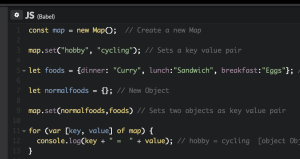- 1. The Ternary Operator
- 2. Short-circuit Evaluation Shorthand
- 3. Declaring Variables Shorthand
- 4. If Presence Shorthand
- 5. JavaScript For Loop Shorthand
- 6. Short-circuit Evaluation
- 7. Decimal Base Exponents
- 8. Object Property Shorthand
- 9. Arrow Functions Shorthand
- 10. Implicit Return Shorthand
- 11. Default Parameter Values
- 12. Template Literals
- 13. Destructuring Assignment Shorthand
- 14. Multi-line String Shorthand
- 15. Spread Operator Shorthand
- 16. Mandatory Parameter Shorthand
- 17. Array.find Shorthand
- 18. Object [key] Shorthand
- 19. Double Bitwise NOT Shorthand
- 20. Exponent Power Shorthand
- 21. Converting a String into a Number
- 22. Object Property Assignment
- 23. Bitwise IndexOf Shorthand
- 24. Object.entries()
- 25. Object.values()
- 26. Suggest One?
- FAQs About JavaScript Shorthand Coding Techniques
This really is a must read for any JavaScript developer. We’ve written this guide to shorthand JavaScript coding techniques that we’ve picked up over the years. To help you understand what is going on, we’ve included the longhand versions to give some coding perspective.
If you want to learn more about ES6 and beyond, check out JavaScript: Novice to Ninja, 2nd Edition.
1. The Ternary Operator
This is a great code saver when you want to write an if..else statement in just one line.
Longhand:
const x = 20;
let answer;
if (x > 10) {
answer = "greater than 10";
} else {
answer = "less than 10";
}
Shorthand:
const answer = x > 10 ? "greater than 10" : "less than 10";
You can also nest your if statement like this:
const answer = x > 10 ? "greater than 10" : x < 5 ? "less than 5" : "between 5 and 10";
2. Short-circuit Evaluation Shorthand
When assigning a variable value to another variable, you may want to ensure that the source variable is not null, undefined, or empty. You can either write a long if statement with multiple conditionals, or use a short-circuit evaluation.
Longhand:
if (variable1 !== null || variable1 !== undefined || variable1 !== '') {
let variable2 = variable1;
}
Shorthand:
const variable2 = variable1 || 'new';
Don’t believe me? Test it yourself (paste the following code in es6console):
let variable1;
let variable2 = variable1 || 'bar';
console.log(variable2 === 'bar'); // prints true
variable1 = 'foo';
variable2 = variable1 || 'bar';
console.log(variable2); // prints foo
Do note that if you set variable1 to false or 0, the value bar will be assigned.
3. Declaring Variables Shorthand
It’s good practice to declare your variable assignments at the beginning of your functions. This shorthand method can save you lots of time and space when declaring multiple variables at the same time.
Longhand:
let x;
let y;
let z = 3;
Shorthand:
let x, y, z=3;
4. If Presence Shorthand
This might be trivial, but worth a mention. When doing “if checks”, assignment operators can sometimes be omitted.
Longhand:
if (likeJavaScript === true)
Shorthand:
if (likeJavaScript)
Note: these two examples are not exactly equal, as the shorthand check will pass as long as
likeJavaScriptis a truthy value.
Here is another example. If a is NOT equal to true, then do something.
Longhand:
let a;
if ( a !== true ) {
// do something...
}
Shorthand:
let a;
if ( !a ) {
// do something...
}
5. JavaScript For Loop Shorthand
This little tip is really useful if you want plain JavaScript and don’t want to rely on external libraries such as jQuery or lodash.
Longhand:
const fruits = ['mango', 'peach', 'banana'];
for (let i = 0; i < fruits.length; i++)
Shorthand:
for (let fruit of fruits)
If you just wanted to access the index, do:
for (let index in fruits)
This also works if you want to access keys in a literal object:
const obj = {continent: 'Africa', country: 'Kenya', city: 'Nairobi'}
for (let key in obj)
console.log(key) // output: continent, country, city
Shorthand for Array.forEach:
function logArrayElements(element, index, array) {
console.log("a[" + index + "] = " + element);
}
[2, 5, 9].forEach(logArrayElements);
// a[0] = 2
// a[1] = 5
// a[2] = 9
6. Short-circuit Evaluation
Instead of writing six lines of code to assign a default value if the intended parameter is null or undefined, we can simply use a short-circuit logical operator and accomplish the same thing with just one line of code.
Longhand:
let dbHost;
if (process.env.DB_HOST) {
dbHost = process.env.DB_HOST;
} else {
dbHost = 'localhost';
}
Shorthand:
const dbHost = process.env.DB_HOST || 'localhost';
7. Decimal Base Exponents
You may have seen this one around. It’s essentially a fancy way to write numbers without the trailing zeros. For example, 1e7 essentially means 1 followed by 7 zeros. It represents a decimal base (which JavaScript interprets as a float type) equal to 10,000,000.
Longhand:
for (let i = 0; i < 10000; i++) {}
Shorthand:
for (let i = 0; i < 1e7; i++) {}
// All the below will evaluate to true
1e0 === 1;
1e1 === 10;
1e2 === 100;
1e3 === 1000;
1e4 === 10000;
1e5 === 100000;
8. Object Property Shorthand
Defining object literals in JavaScript makes life much easier. ES6 provides an even easier way of assigning properties to objects. If the variable name is the same as the object key, you can take advantage of the shorthand notation.
Longhand:
const x = 1920, y = 1080;
const obj = { x:x, y:y };
Shorthand:
const obj = { x, y };
9. Arrow Functions Shorthand
Classical functions are easy to read and write in their plain form, but they do tend to become a bit verbose and confusing once you start nesting them in other function calls.
Longhand:
function sayHello(name) {
console.log('Hello', name);
}
setTimeout(function() {
console.log('Loaded')
}, 2000);
list.forEach(function(item) {
console.log(item);
});
Shorthand:
sayHello = name => console.log('Hello', name);
setTimeout(() => console.log('Loaded'), 2000);
list.forEach(item => console.log(item));
It’s important to note that the value of this inside an arrow function is determined differently than for longhand functions, so the two examples are not strictly equivalent. See this article on arrow function syntax for more details.
10. Implicit Return Shorthand
Return is a keyword we use often to return the final result of a function. An arrow function with a single statement will implicitly return the result its evaluation (the function must omit the braces ({}) in order to omit the return keyword).
To return a multi-line statement (such as an object literal), it’s necessary to use () instead of {} to wrap your function body. This ensures the code is evaluated as a single statement.
Longhand:
function calcCircumference(diameter) {
return Math.PI * diameter
}
Shorthand:
calcCircumference = diameter => (
Math.PI * diameter;
)
11. Default Parameter Values
You can use the if statement to define default values for function parameters. In ES6, you can define the default values in the function declaration itself.
Longhand:
function volume(l, w, h) {
if (w === undefined)
w = 3;
if (h === undefined)
h = 4;
return l * w * h;
}
Shorthand:
volume = (l, w = 3, h = 4 ) => (l * w * h);
volume(2) //output: 24
12. Template Literals
Aren’t you tired of using ' + ' to concatenate multiple variables into a string? Isn’t there a much easier way of doing this? If you are able to use ES6, then you are in luck. All you need to do is use is the backtick, and ${} to enclose your variables.
Longhand:
const welcome = 'You have logged in as ' + first + ' ' + last + '.'
const db = 'http://' + host + ':' + port + '/' + database;
Shorthand:
const welcome = `You have logged in as ${first} ${last}`;
const db = `http://${host}:${port}/${database}`;
13. Destructuring Assignment Shorthand
If you are working with any popular web framework, there are high chances you will be using arrays or data in the form of object literals to pass information between components and APIs. Once the data object reaches a component, you’ll need to unpack it.
Longhand:
const observable = require('mobx/observable');
const action = require('mobx/action');
const runInAction = require('mobx/runInAction');
const store = this.props.store;
const form = this.props.form;
const loading = this.props.loading;
const errors = this.props.errors;
const entity = this.props.entity;
Shorthand:
import { observable, action, runInAction } from 'mobx';
const { store, form, loading, errors, entity } = this.props;
You can even assign your own variable names:
const { store, form, loading, errors, entity:contact } = this.props;
14. Multi-line String Shorthand
If you have ever found yourself in need of writing multi-line strings in code, this is how you would write it:
Longhand:
const lorem = 'Lorem ipsum dolor sit amet, consectetur\n\t'
+ 'adipisicing elit, sed do eiusmod tempor incididunt\n\t'
+ 'ut labore et dolore magna aliqua. Ut enim ad minim\n\t'
+ 'veniam, quis nostrud exercitation ullamco laboris\n\t'
+ 'nisi ut aliquip ex ea commodo consequat. Duis aute\n\t'
+ 'irure dolor in reprehenderit in voluptate velit esse.\n\t'
But there is an easier way. Just use backticks.
Shorthand:
const lorem = `Lorem ipsum dolor sit amet, consectetur
adipisicing elit, sed do eiusmod tempor incididunt
ut labore et dolore magna aliqua. Ut enim ad minim
veniam, quis nostrud exercitation ullamco laboris
nisi ut aliquip ex ea commodo consequat. Duis aute
irure dolor in reprehenderit in voluptate velit esse.`
15. Spread Operator Shorthand
The spread operator, introduced in ES6, has several use cases that make JavaScript code more efficient and fun to use. It can be used to replace certain array functions. The spread operator is simply a series of three dots.
Longhand
// joining arrays
const odd = [1, 3, 5];
const nums = [2 ,4 , 6].concat(odd);
// cloning arrays
const arr = [1, 2, 3, 4];
const arr2 = arr.slice()
Shorthand:
// joining arrays
const odd = [1, 3, 5 ];
const nums = [2 ,4 , 6, ...odd];
console.log(nums); // [ 2, 4, 6, 1, 3, 5 ]
// cloning arrays
const arr = [1, 2, 3, 4];
const arr2 = [...arr];
Unlike the concat() function, you can use the spread operator to insert an array anywhere inside another array.
const odd = [1, 3, 5 ];
const nums = [2, ...odd, 4 , 6];
You can also combine the spread operator with ES6 destructuring notation:
const { a, b, ...z } = { a: 1, b: 2, c: 3, d: 4 };
console.log(a) // 1
console.log(b) // 2
console.log(z) // { c: 3, d: 4 }
16. Mandatory Parameter Shorthand
By default, JavaScript will set function parameters to undefined if they are not passed a value. Some other languages will throw a warning or error. To enforce parameter assignment, you can use an if statement to throw an error if undefined, or you can take advantage of the ‘Mandatory parameter shorthand’.
Longhand:
function foo(bar) {
if(bar === undefined) {
throw new Error('Missing parameter!');
}
return bar;
}
Shorthand:
mandatory = () => {
throw new Error('Missing parameter!');
}
foo = (bar = mandatory()) => {
return bar;
}
17. Array.find Shorthand
If you have ever been tasked with writing a find function in plain JavaScript, you would probably have used a for loop. In ES6, a new array function named find() was introduced.
Longhand:
const pets = [
{ type: 'Dog', name: 'Max'},
{ type: 'Cat', name: 'Karl'},
{ type: 'Dog', name: 'Tommy'},
]
function findDog(name) {
for(let i = 0; i<pets.length; ++i) {
if(pets[i].type === 'Dog' && pets[i].name === name) {
return pets[i];
}
}
}
Shorthand:
pet = pets.find(pet => pet.type ==='Dog' && pet.name === 'Tommy');
console.log(pet); // { type: 'Dog', name: 'Tommy' }
18. Object [key] Shorthand
Did you know that Foo.bar can also be written as Foo['bar']? At first, there doesn’t seem to be a reason why you should write it like that. However, this notation gives you the building block for writing re-usable code.
Consider this simplified example of a validation function:
function validate(values) {
if(!values.first)
return false;
if(!values.last)
return false;
return true;
}
console.log(validate({first:'Bruce',last:'Wayne'})); // true
This function does its job perfectly. However, consider a scenario where you have very many forms where you need to apply the validation but with different fields and rules. Wouldn’t it be nice to build a generic validation function that can be configured at runtime?
Shorthand:
// object validation rules
const schema = {
first: {
required:true
},
last: {
required:true
}
}
// universal validation function
const validate = (schema, values) => {
for(field in schema) {
if(schema[field].required) {
if(!values[field]) {
return false;
}
}
}
return true;
}
console.log(validate(schema, {first:'Bruce'})); // false
console.log(validate(schema, {first:'Bruce',last:'Wayne'})); // true
Now we have a validate function we can reuse in all forms without needing to write a custom validation function for each.
19. Double Bitwise NOT Shorthand
Bitwise operators are one of those features you learn about in beginner JavaScript tutorials and you never get to implement them anywhere. Besides, who wants to work with ones and zeroes if you are not dealing with binary?
There is, however, a very practical use case for the Double Bitwise NOT operator. You can use it as a replacement for Math.floor(). The advantage of the Double Bitwise NOT operator is that it performs the same operation much faster. You can read more about Bitwise operators here.
Longhand:
Math.floor(4.9) === 4 //true
Shorthand:
~~4.9 === 4 //true
20. Exponent Power Shorthand
Shorthand for a Math exponent power function:
Longhand:
Math.pow(2,3); // 8
Math.pow(2,2); // 4
Math.pow(4,3); // 64
Shorthand:
2**3 // 8
2**4 // 4
4**3 // 64
21. Converting a String into a Number
There are times when your code receives data that comes in String format but needs to processed in Numerical format. It’s not a big deal, we can perform a quick conversion.
Longhand:
const num1 = parseInt("100");
const num2 = parseFloat("100.01");
Shorthand:
const num1 = +"100"; // converts to int data type
const num2 = +"100.01"; // converts to float data type
22. Object Property Assignment
Consider the following piece of code:
let fname = { firstName : 'Black' };
let lname = { lastName : 'Panther'}
How would you merge them into one object? One way is to write a function that copies data from the second object onto the first one. Unfortunately, this might not be what you want — you may need to create an entirely new object without mutating any of the existing objects. The easiest way is to use the Object.assign function introduced in ES6:
let full_names = Object.assign(fname, lname);
You can also use the object destruction notation introduced in ES8:
let full_names = {...fname, ...lname};
There is no limit to the number of object properties you can merge. If you do have objects with identical property names, values will be overwritten in the order they were merged.
23. Bitwise IndexOf Shorthand
When performing a lookup using an array, the indexOf() function is used to retrieve the position of the item you are looking for. If the item is not found, the value -1 is returned. In JavaScript, 0 is considered ‘falsy’, while numbers greater or lesser than 0 are considered ‘truthy’. As a result, one has to write the correct code like this.
Longhand:
if(arr.indexOf(item) > -1) { // Confirm item IS found
}
if(arr.indexOf(item) === -1) { // Confirm item IS NOT found
}
Shorthand:
if(~arr.indexOf(item)) { // Confirm item IS found
}
if(!~arr.indexOf(item)) { // Confirm item IS NOT found
}
The bitwise(~) operator will return a truthy value for anything but -1. Negating it is as simple as doing !~. Alternatively, we can also use the includes() function:
if(arr.includes(item)) { // Returns true if the item exists, false if it doesn't
}
24. Object.entries()
This is a feature that was introduced in ES8 that allows you to convert a literal object into a key/value pair array. See the example below:
const credits = { producer: 'John', director: 'Jane', assistant: 'Peter' };
const arr = Object.entries(credits);
console.log(arr);
/** Output:
[ [ 'producer', 'John' ],
[ 'director', 'Jane' ],
[ 'assistant', 'Peter' ]
]
**/
25. Object.values()
This is also a new feature introduced in ES8 that performs a similar function to Object.entries(), but without the key part:
const credits = { producer: 'John', director: 'Jane', assistant: 'Peter' };
const arr = Object.values(credits);
console.log(arr);
/** Output:
[ 'John', 'Jane', 'Peter' ]
**/
26. Suggest One?
I really do love these and would love to find more, so please leave a comment if you know of one!
FAQs About JavaScript Shorthand Coding Techniques
What are some of the most common shorthand techniques in JavaScript?
JavaScript shorthand techniques are a way to write more efficient and cleaner code. Some of the most common shorthand techniques include the Ternary Operator, which is a shorter way of writing an if-else statement, and the Nullish Coalescing Operator, which returns the first argument if it’s not null or undefined. Other common shorthand techniques include the Optional Chaining Operator, which allows you to access deeply nested object properties without checking if each property exists, and the Logical OR Assignment (||=), which assigns a value to a variable only if the variable is nullish.
How can shorthand techniques save time when coding in JavaScript?
Shorthand techniques can significantly reduce the amount of code you need to write, making your code more readable and easier to maintain. They can also make your code run faster, as less code means less processing time. Additionally, shorthand techniques can help prevent errors, as they often include built-in error checking.
Are there any drawbacks to using shorthand techniques in JavaScript?
While shorthand techniques can make your code more efficient and easier to read, they can also make it more difficult for beginners to understand. If you’re working on a team with less experienced developers, you may need to spend extra time explaining how these techniques work. Additionally, some shorthand techniques may not be supported in older browsers, so you’ll need to make sure your code is compatible with the browsers your audience is using.
Can you provide some examples of how to use shorthand techniques in JavaScript?
Sure, here are a few examples. To use the Ternary Operator, you could write `let result = (a > b) ? ‘a is greater’ : ‘b is greater’;` instead of using a full if-else statement. To use the Nullish Coalescing Operator, you could write `let result = a ?? ‘default’;` to assign a default value to a variable if it’s null or undefined.
What are some resources for learning more about shorthand techniques in JavaScript?
There are many online resources for learning about JavaScript shorthand techniques. The Mozilla Developer Network (MDN) has comprehensive documentation on JavaScript, including a section on shorthand techniques. You can also find tutorials and articles on websites like SitePoint, Plain English, and Geeks for Geeks.
How can I practice using shorthand techniques in JavaScript?
The best way to practice using shorthand techniques is to incorporate them into your own code. Try rewriting some of your existing code using these techniques, and see how it affects the readability and efficiency of your code. You can also try solving coding challenges on websites like HackerRank or LeetCode, which can help you get comfortable with these techniques in a variety of contexts.
Are shorthand techniques used in other programming languages?
Yes, shorthand techniques are used in many other programming languages, including Python, Ruby, and C++. While the specific techniques and syntax may vary, the underlying principles are the same: to write more efficient, readable code.
How can I remember all the different shorthand techniques in JavaScript?
It can be challenging to remember all the different shorthand techniques, especially if you’re new to JavaScript. One strategy is to focus on learning one technique at a time, and practice using it until it becomes second nature. You can also keep a cheat sheet handy for quick reference.
Can shorthand techniques affect the performance of my JavaScript code?
Yes, shorthand techniques can improve the performance of your code by reducing the amount of code that needs to be processed. However, the impact on performance is usually minimal, and it’s more important to focus on writing clear, maintainable code.
Are there any shorthand techniques that are considered bad practice?
While most shorthand techniques are considered good practice, there are a few that can be confusing or lead to unexpected behavior. For example, using the ‘==’ operator for equality checks can lead to unexpected type coercion, so it’s generally recommended to use the ‘===’ operator instead. Similarly, using the ‘&&’ operator for conditional execution can be confusing if you’re not familiar with how it works. It’s always important to understand how a shorthand technique works before using it in your code.
I write clean, readable and modular code. I love learning new technologies that bring efficiencies and increased productivity to my workflow.
 Sam Deering
Sam DeeringSam Deering has 15+ years of programming and website development experience. He was a website consultant at Console, ABC News, Flight Centre, Sapient Nitro, and the QLD Government and runs a tech blog with over 1 million views per month. Currently, Sam is the Founder of Crypto News, Australia.




